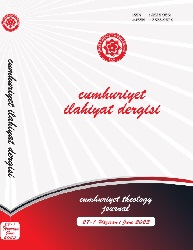Osmanlı Kaynakları Işığında Toprak Kadılığı
The Land Judgeships in the Light of Ottoman Sources
Author(s): Nevzat ErkanSubject(s): History of Law, 16th Century, The Ottoman Empire, Sharia Law
Published by: Cumhuriyet Üniversitesi İlahyat Fakültesi
Keywords: Ottoman; Archive; Judiciary Organization; Qadi Institution; Land Judgeship;
Summary/Abstract: In the 16th century, Ottoman judicial system has a type of qadi which is mentioned as a land judge in both Rumelia and Anatolian provinces. In the Ottoman legal system, besides the province, sanjak, district, and army judges, there was an independent qadi under the name of territorial kadi. If there is an independent land judge, what exactly was the chatacteristics and quality of this qadi? In order to find answers to such questions on the subject, it is necessary to focus on how the land qadi is handled, evaluated, what findings or assumptions are put forward about its emergence and historical process in scientific studies, and more importantly, it is necessary to test the existing knowledge and assumptions based on primary sources. The territorial judgeship, which is subject to different evaluations in terms of its characteristics, has been handled as a mobile qadi who was in charge of the inspection by Ottoman historians since İsmail Hakkı Uzunçarşılı. Recently, some legal historians have put forward the idea that the land judge was a local judge. On the occasion of this research, the focus is on the types of Ottoman archive documents in which the concept has been used. In this study, the practice of being a qadi of land, which is mentioned in the Ottoman documents for a period of almost two centuries, has been discussed within the framework of the opinions expressed on the subject, archive records, şer’iyye registers, fatwa books, and law books issued in the relevant periods. First of all, in order to understand the nature of the land judge, the archive records in which the expression is frequently included were examined. In particular, documents containing subjects such as inheritance cases, provision of supplies, and tax assessment, especially the duty of inspection and investigation, which misled researchers, were evaluated. Secondly, archival records pointing to the possibility of an independent qadi of the land qadi are discussed. This concept, which is the subject of the research, is mentioned in some archive documents together with the local judges. This situation is one of the main motives behind the claims that the land qadi constitutes an independent class of judges. However, studies suggesting that there is another authorized qadi alongside the local qadis seem to have overlooked other possibilities. Similarly, within the classical period Ottoman justice mechanism, there were mostly high-level viziers and statesmen such as judges, under the name of Mehayif Inspector, who were sent from the center to detect the injustices and irregularities committed by the people of the province in the provinces. In some archive records, the mention of mehayif inspectors together with the land judges has led to the perception that they are mobile judges. The first thing that draws attention is the fact that the district judgeships are not repeated in the documents in accordance with a writing procedure. It should be noted that when only one person is selected for the Mehayif inspection, the possibility that many other mobile judges can be appointed as auxiliary elements besides the district judges is not very logical. In the last part of the study, the real characteristics of the land qadi is emphasized. Documents clearly indicating that he is a district/qadi are also discussed. Issues such as the division of inheritance mentioned in these records, hearing a case that has been dropped, fall within the jurisdiction of the district or town judges, not the work of the itinerant judges. In addition, what is meant in the archive record in which the phrase “court place of the land judge” is included is nothing but the qadi of that town. Thus, the court place/building is not mobile, but it is the place where local qadis can work. Finally, it is important to answer another question that we have outlined about the documents regarding the possibility that the Kaza qadis and the territorial qadis may be separate persons: Why is the term of “territorial qadi” included in the documents, unlike the county judges? If a lawsuit or issue in region or town more than one city, county, township etc outside that place concerns the administrative unit and the qadis here oversee the resolution of the case together, the qadi in charge of the place where the incident occurred in terms of the main place of the case and the nature of the task is called a territorial qadi in order to distinguish it from the others. Similarly, it can be seen in other examples in the documents that wherever the place of action and problem in a case presented to a town judge outside, the district judge in the aforementioned district was also involved in the case and was qualified as a land judge to indicate his position. This statement is similar to the jurisdiction of the court of the place where the incident took place in terms of appropriateness and authority in today’s judicial system.
Journal: Cumhuriyet İlahiyat Dergisi
- Issue Year: 27/2023
- Issue No: 1
- Page Range: 209-220
- Page Count: 12
- Language: Turkish

